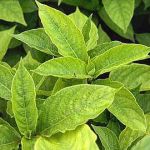| Common Name: |
Two-toothed Amaranthus |
| Other Names: |
Amaranth |
| Botanical Name: |
Achyranthes bidentata |
| Genus: |
Achyranthes |
| Family: |
Amaranthaceae |
| Native Location: |
E and SE Asia, naturalized in S USA. |
| Cultivation: |
Rich, deep, well-drained soil, ideally sandy and slightly acidic, in partial shade. |
| Propagation: |
By seed sown in late spring. |
| Harvest: |
Leaves and stems are picked in summer and crushed for juice or used in tinctures. Roots are lifted in autumn or winter from one or two-year-old plants and sun-dried for use in decoctions, liquid extracts, pills, and powders. The drying process often involves a stage of stir-frying with rice wine. Fresh root is used in southern China. |
| height: |
38cm-1m (15-36in) |
| Width: |
23-45cm (9-18in) |
| Hardiness: |
Z8-9 |
| Parts Used: |
Roots (huai nui xi), leaves, stems |
| Properties: |
A bitter, acrid herb that stimulates the circulatory and digestive systems, liver and kidneys, lowering blood pressure and relieving pain. Acts mostly on the lower half of the body. Research suggests it dilates the cervix and is therefore inadvisable for use during pregnancy. |
| Medicinal Uses: |
Internally for blood in urine, hypertension, low back and joint, menstrual, and postpartum pain, nosebleeds, and bleeding gums. |
| Bibliography: |
Encyclopedia of Herbs by Deni Brown. Copyright © 1995, 2001 Dorling Kindersley Limites. pp 99-100.
|

